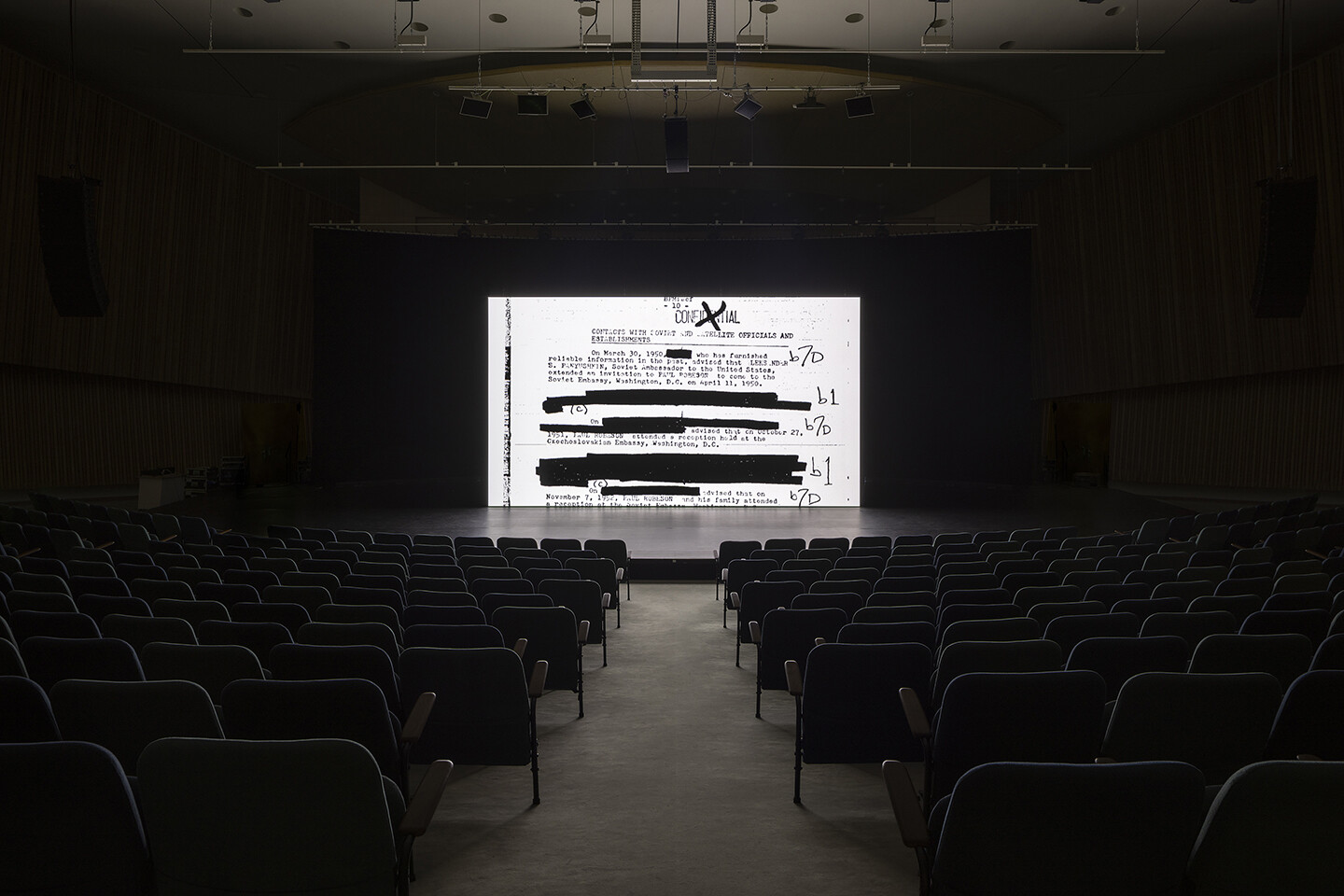Steve McQueen’s audio-visual installation End Credits (2012–22) displays thousands of digitized FBI files scrolling slowly up a large-scale screen over twelve hours and fifty-four minutes. The material includes file numbers, dates, and registration codes, some heavily redacted or blacked out. Over the duration of sixty-seven hours, four minutes, and forty-three seconds, voice recordings render the FBI informants’ reports audible asynchronously to the image. The artwork is a haunting monument to the state surveillance and smear campaigns orchestrated by the US government against the writer, photographer, Pan-Africanist, feminist, and anthropologist Eslanda Robeson (1895–1965). Robeson also managed the media communication of her husband, the world-renowned singer, actor, lawyer, and social activist Paul Robeson (1898–1976), who was also under attack by the FBI for his civil rights work, support of trade unions, and sympathy for Soviet-communist ideas. Eslanda wrote a biography of Paul as well.
Although often overshadowed by her husband, Eslanda Goode Cardozo Robeson was an outstanding intellectual. She studied with anthropologist Bronisław Malinowski at the London School of Economics in the 1930s. She was a brilliant photographer and developed an anti-colonial feminism in and beyond the discipline.1 Her politics shaped her photographic practice during her journeys to the Congo, Uganda, and South Africa;2 the scholar Leigh Raiford has described her perspective as a “pan-African gaze.” Paul Robeson connected the Black civil rights movement and the workers’ movement to an interracial, anti-colonial internationalism through the sonic traditions of East African music, European chorales, and Negro spirituals. Both Robesons made significant contributions to the Black avant-garde of the Harlem Renaissance, and they continue to influence generations of Black diasporic imaginaries. Their work also circulated in the mainstream media of minor socialist countries, such as the German Democratic Republic (GDR) and the Czech Republic.
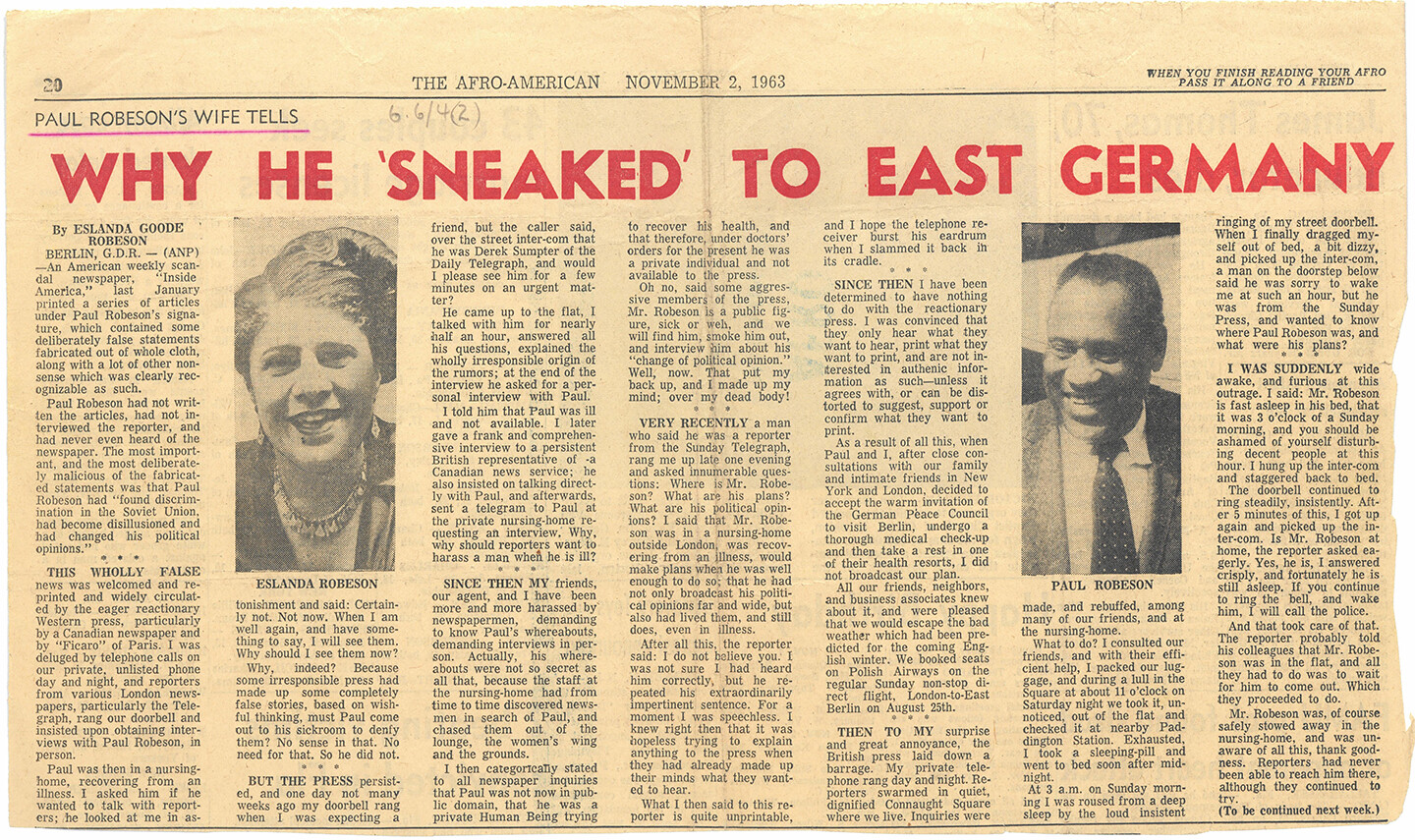

Eslanda Goode Robeson in The Afro-American, weekly newspaper, November 2, 1963. Part one of a three-part article. (c) Paul Robeson Archive, PRA 346, Akademie der Künste, Berlin.
They were banned from travel and work outside the US between 1950 and 1958 and were interrogated by the notorious House Un-American Activities Committee. However, they were supported and honored by intellectuals, students, anti-fascist activists, and governmental representatives in communist and nonaligned countries around the world. Among their supporters was the Jewish-German philosopher Franz Loeser and his wife, Diana Loeser, an “English for you” teacher on GDR television. In the East German version of his autobiography, Franz Loeser’s writes that as a student at the University of Minnesota he safeguarded Paul Robeson against a mob of white supremacists during the Peekskill riots in 1949.3 Shortly after that attack, Loeser himself became subject to the anti-communist policy of the US and needed to leave the country. After a stay in Manchester for a few years, he moved to East Berlin in 1957, where he contributed significantly to building the Paul Robeson Archive at the Akademie der Künste in East Berlin, of which Paul Robeson became a corresponding member in 1963. His membership was cancelled around 1994 when the Akademie der Künste East was “reunited” with the Akademie der Künste West.
In other words, the aftermath of the global Cold War not only disregarded the archives and silenced the histories of communist and anti-fascist lives in Europe. It also erased the presence in these geographies of Black radical histories and their transcontinental networks. In the context of East Germany, this double erasure, which the sociologist Katharina Warda has described as a “double invisibilization” by white patriarchal liberal power, created the conditions for the ethno-nationalism and neofascism that we face today.4 Or, as Charisse Burden Stelly argues, being Black and communist is that which fascists fear most.5
The ongoing instrumentalization of memory politics, particularly concerning the fights against racism and anti-Semitism, makes it urgent to engage with unfinished conversations between friends and movements that created intersectional solidarity between East and South struggles. In End Credits, McQueen invokes these geopolitical entanglements through an artistic mobilization of archival material, which enables viewers to link racism with colonialism, anti-Semitism, and fascism. The following conversation about End Credits took place on October 25, 2022, during the lead-up to the first full-length exhibition of the work, at the Haus der Kulturen der Welt in Berlin, in the context of the multipart curatorial project “The Missed Seminar.”6
—Doreen Mende
***
Doreen Mende: End Credits exhibits an aesthetics of bureaucracy and a pathology of administration as methods of anti-communist horror during the postwar McCarthyite regime in the name of US law. The FBI files documenting the surveillance of Eslanda and Paul Robeson span the period between 1941 and 1978. The excessive number of files and registration codes indicate the quality and quantity of surveillance, and reveal the building blocks of state terror in the name of racial liberal democracy. The hi-res FBI material used in End Credits is accessible today, but it used to be classified, top secret, and FBI coded. How does this expose the surveillance system while invisibilizing the Robesons? What remains indiscernible despite the high-resolution exposure?
Steve McQueen: What was fascinating to me when I first saw the documents was the erasure of certain information within them. There was a structure. Things which were revealed were sealed. It was done in such an orderly fashion because, of course, these things were classified. Now they’re unclassified, but they’re still classified in a way because we don’t see all the evidence or facts that had apparently been gathered. It’s decorative to a certain extent: what is revealed and what is unrevealed, what is fact and what is fiction. So then it’s about what the spectator projects onto those files. The blackness was almost like holes within the system. Those holes tell you a lot about the failures of state surveillance, and more than anything, about the triumphs of the Robesons.
DM: Imagining the erasures in the files as blackness, or as holes in the system, creates such a beautiful optics. It immediately turns the spectator’s perspective toward the unboundedness of human existence, and specifically the Robesons’ unconventional lives. It suggests the possibility of futurity, or, as you put it, blurs the lines between fact and fiction. At the same time, there is still much intimate information accessible. You’ve also just said that End Credits invites the audience to make something out of what they imagine. How do you cope with the exposure of intimate information about the Robesons—their illnesses, struggles, relationship problems, love affairs, friendships, mental problems, and health issues? The first audience for the files were secret service operatives. What does shifting the material of the FBI files into an art space allow? How do you deal with the intimacy?
SM: If anything, it makes them more heroic. Their vulnerabilities were their strengths. These were as important to document as their political activism. This tells you how scared the FBI was of them. In just an emotional sense, for me, it makes them more endearing as characters, because they were real people who were intimidated to the point of madness. And also a lot of those things—health and the trouble with their relationship—were instigated, were activated, by the FBI themselves.
DM: The files are also evidence of their resistance and their fearlessness in their love.
SM: I would say.
DM: The complete End Credits has about twelve hours of video and sixty-seven hours of audio. There is also an asynchronous relationship between the audio and video. It’s obviously a profoundly different time-concept than your film-production work. In your film productions you are tied to the feature length of the film. How do you mobilize duration as a methodology in End Credits differently from your film productions?
SM: It’s very different. It’s about duration and meditation. I’m not asking the audience to sit through sixty-seven hours straight, it’s about what you take and what you bring. It’s about the fact that once you leave the space you know that it’s still going on. It’s like a painting. It doesn’t just survive on the wall, it’s an aspect of something. It brings you to a point and you grow and work with it. And that’s why you can keep going back to the same image. End Credits tracks the constant surveillance of the Robesons until two years after Paul’s death in 1976. We have to have this journey into his surveillance because it is about constant surveillance over an elongated period of time. Either you are in the room or you are not, but you carry it with you.
DM: As a spectator?
SM: Of course, yes. You can imagine how this was going on for such a long period of time. It was relentless. The whole idea of End Credits was of a film with this sort of scroll of information that just goes on and on and on. That’s what I wanted to represent within the context of an artwork in order to replicate or visualize this, to carry the weight in some way.
DM: End Credits exposes the paratext of a plot, of a narrative, of a life. We could say that the duration is an indicator of the surveillance apparatus? On the other hand, could we say that this surveillance did not define the life of Eslanda and Paul Robeson?
SM: Absolutely.
DM: End Credits was presented at the Haus der Kulturen der Welt (HKW) in Berlin for the first time in complete form. It was shown in the context of the “The Missed Seminar,” which is a multipart curatorial research project that seeks to metabolize archival material documenting the presence of the Robesons in the context of the communist geographies of Europe, specifically in the German Democratic Republic, in light of Eslanda’s journeys to the Continent. HKW was built in 1957 as the home for the congress of West Berlin; it is an articulation of Cold War architecture par excellence. In opposition to the people of East Berlin, quite literally at their border, the Congress Hall was designed to promote anti-communism as a condition for de-Nazification and “freedom.” Thus, your installation in Berlin denounces, both in curatorial and juridical terms, the promises of liberal democracy as a tool of war. What are your thoughts regarding the presentation of End Credits at HKW, a building that was originally gifted by the same US government that banned the Robesons from traveling? What are your thoughts about presenting End Credits in the belly of the beast, so to speak, in architecture that was built from the same political violence that surveilled them?
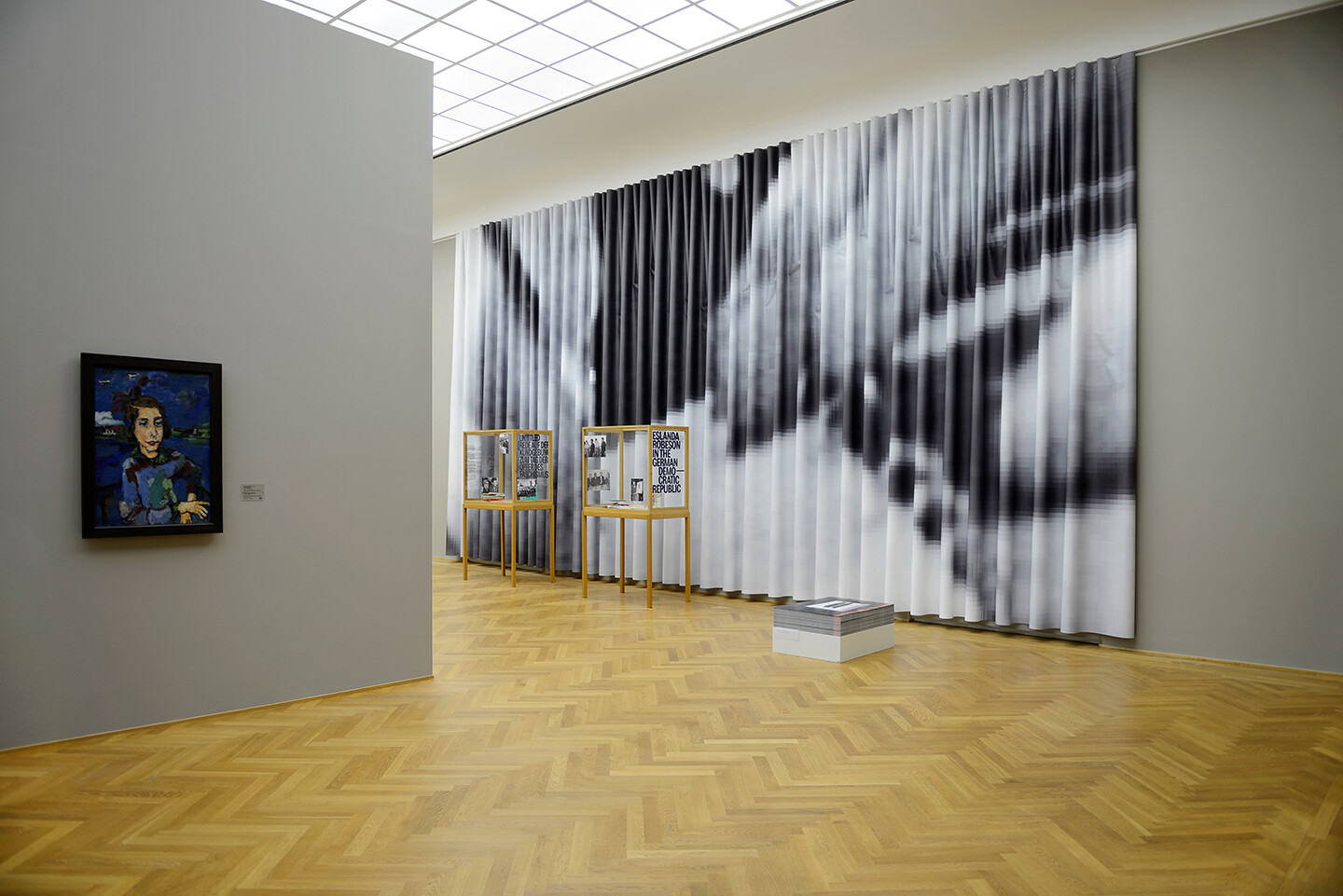

“The Missed Seminar,” Albertinum, Dresden, March 31–September 24, 2023. Installation view. Dresden State Art Collections © Albertinum, Staatliche Kunstsammlungen Dresden. Photo: Elke Estel/Hans-Peter Klut, 2023.
SM: In some ways it’s bringing it back home, which is kind of interesting to witness. This is how the situation always ends up. But at the same time, I don’t know what that means. We now have the advantage of time. And time allows this kind of orchestration where we can put a project about surveillance in a place of surveillance. I don’t know if that is a victory or if that’s irony, I have no idea. It’s something to witness and I’m looking forward to seeing it in that space and seeing what happens. I can only really answer that question once I have seen it in the space.
DM: HKW is not a neutral venue—not that there is ever a neutral exhibition space. Perhaps it’s a victory to exhibit End Credits at HKW, because exposing the files of surveillance confronts the venue itself as an exhibition of that violence.
SM: I don’t know if it’s a victory. Many people have lost along the way. Many people didn’t survive to see this. It’s the long game. And I don’t know what it is. Is it a triumph? Or is it a defeat?
DM: It’s a past in the present, it’s a longue durée.
SM: It’s not celebratory at all.
DM: I agree.
SM: At the same time, I don’t know if it’s defeat. But I can witness it.
DM: Would you say that it’s a form of manifestation?
SM: No. You’re the one putting it there, not me. I don’t know if it’s a demonstration or superfluous. These things are gone, and other things are happening already. New surveillance and new kinds of observations are happening as we speak on this call, wherever. It just goes on in different forms. I don’t know who the victors are, but it is what it is.
DM: The post-1990 political depression still resonating in the present was one motivation for me to engage with the narratives, lives, and struggles of the Robesons. What kind of space do you think reconnecting with their legacies opens up? What do we learn from thinking about the legacies of the anti-communist witch hunts and communist alliances across race and geographies from a contemporary perspective?
SM: What you learn from it is what you’re willing to surrender for a sense of liberty. And not a lot of people are willing. As we all know now, we’ve all surrendered to it to a certain extent with our phones and our computers. We know that there is surveillance, we know that we’re being monitored. And we surrender to it. Because in some ways what has happened is that we’ve been put into a position where we can’t function without it. And that’s it. We’re put into a position [where we need to ask ourselves] what are you willing to give up, what are you willing to sacrifice. It’s very difficult. The structures of power and authority have made it—I don’t want to say impossible, but at least very difficult—to not be in their pocket one way or the other. Freedom is just whatever that is, I’m not too sure.
DM: Absolutely. It brings us back to the exhibition venue’s history. It was built on the premise of liberal democracy and the idea of freedom. Yet, freedom here is a tool of war. And that’s what I think becomes pertinent and palpable by engaging and reconnecting with the Robesons through End Credits. Maybe to ask differently: Why End Credits today?
SM: Interesting. Why End Credits today? It’s an interesting topic when you think of all these whistleblowers and what’s going on around the world. What I wanted to do in one way, shape, or form was to be very direct, because I think these FBI files are quite formal. It’s literally black and white. There is a tactility to it that allows engaging with people in a very direct manner. Why now? Because you can see these things in a very direct fashion: the narrative of people being surveilled for over thirty years and the toll that it takes and how it chips away at this couple—Paul in particular. The mental health issues, and so forth. And therefore, I had hoped seeing these documents in this narrative form would trigger people to reflect upon their own individual situations and how we live today. This is basically all one can do, to reflect on the past. And to reflect on the past in the present.
DM: What kind of thinking do you hope End Credits produces? Is it a trans-generational thinking? A communist thinking? A Pan-African thinking? A politics of friendship thinking?
SM: I wouldn’t want to say. That’s not for me. I’m not here to direct people’s thoughts. It’s the exact opposite. It’s about reflecting on the present within the past, or the past in the present. Otherwise, I have no idea. The fact that people can view it is as much as I could hope for.
DM: Let’s speak about the Transatlantic Telephone Concert, which transmitted the voice of Paul Robeson live—for the first time across the Atlantic—to St. Pancras Town Hall in London on May 26, 1957. I remember you talking enthusiastically with the curator Donna DeSalvo about it in 2016.7 The concert was organized by the German-Jewish Marxist philosopher Franz Loeser, a friend of Paul’s. The Transatlantic Telephone Concert was an incredibly important act of solidarity against the US governmental travel ban that had prevented Paul Robeson from performing in Europe. It was also an important moment of friendship between Robeson and Loeser. Later that year, Loeser immigrated to East Berlin, where he mobilized a state-approved initiative to support Robeson, demanding the end of the anti-communist travel ban. Robeson is as famous for a generation born after the 1940s in East Germany as Angela Davis is for a generation born after the 1960s. This friendship, and the concert, has also been a main interest of “The Missed Seminar.” What fascinates you about the Transatlantic Telephone Concert? What does it allow us to imagine?
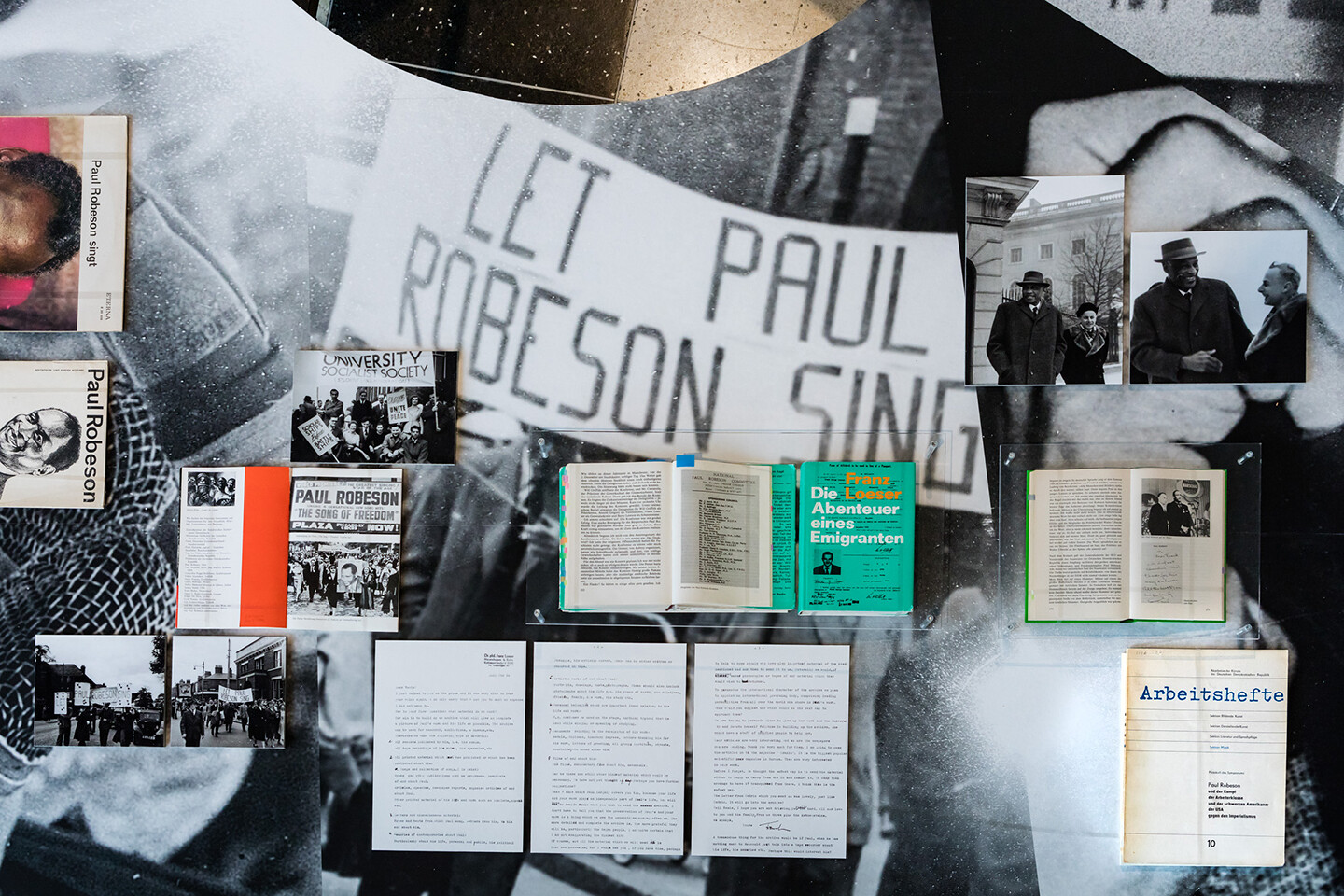

“The Missed Seminar,” Haus der Kulturen der Welt, Berlin, October 28–December 30, 2022; and Staatliche Kunstsammlungen Dresden, March 30–September 24, 2023. © Laura Fiorio, 2022.
SM: I think breaking the lines. The fact that where there’s a will, there’s a way. And that’s what art can do. Art has always been a tool, has always been a thing that can transform and transcend a situation. And I think that’s a great example of that. The whole idea of a voice can actually generate that amount of enthusiasm and love. And you can echo that with End Credits in terms of voices, those voices can actually reverberate and communicate.
DM: On August 27, 1963, a few days after their arrival in East Berlin, Eslanda wrote a kind of report called “Kidnapped!” A True Story, documenting their escape from the media harassment they had experienced in London.8 Both she and Paul had moved to London between 1958 and 1963, shortly after the travel ban was ended. Journalists besieged their house at Connaught Square in London, hunting for any sorts of information on the Robesons, specifically on Paul’s health. In “Kidnapped!” A True Story, Eslanda describes in detail their tricks to fool the waiting journalists: boarding a Polish Airlines plane to East Berlin, meeting Loeser at the airport, and the welcome by the Peace Council in East Berlin that had invited them. Eslanda writes in a diaristic form. Hers is a kind of auto-theory writing, taking lived experience as a foundation to analyze political realities. It situates her approach in the tradition of Black diaristic writing—Zora Neale Hurston, Nella Larsen, and authors around The Crisis, a journal founded by W. E. B. DuBois, in which literature intersects with memoir and journalistic reports. Eslanda’s many writings, which remain to be published as an anthology, evidence Black life as well as her commitment to a Pan-African feminism. “Kidnapped!” A True Story was published in three parts in The Afro-American newspaper in November 1963.
SM: Which newspaper?
DM: It’s called The Afro-American. To my knowledge, it was founded in 1892 in Baltimore, starting as a daily newspaper and later becoming a weekly newspaper, with nine national editions published in several major cities across the US around the time Eslanda was publishing with them. The first part of “Kidnapped!” was titled “Why he ‘sneaked’ to East Germany,” and was published on November 2, 1963. The second part, published a week later, was titled “Escape reads like a movie thriller,” and the third part is “Only trying to get Paul a rest,” published on November 16, 1963. I share this with you is to ask: Why do you think there’s no feature film on Paul and Eslanda Robeson yet?
SM: More than ten years ago I tried to do something on the subject, but it proved very difficult to deal with the estate and the family. It’s understandable. There’s a lot going on with their legacy.
DM: Eslanda’s writings, as well as all the material in archives such as the Akademie der Künste in Berlin but also in the FBI files, operate like a script for a film that imagines their lives.
SM: No, it’s not about imagining. It’s a fact. It’s actuality. It’s fact and it’s fiction. And there it is, and in that duration of End Credits. This is my picture, my film, on the Robesons. It couldn’t have been anything else. This was it. Sometimes you’re looking at something and you think you should go a certain way and actually, it’s right in front of you. And I discovered that this was the ultimate picture that I could make of the Robesons, of Paul. I think biographical films are very tricky. I haven’t really made one. They’re particularly tricky with historical characters. With these files I made my narrative. It’s a document. It’s documentary, it’s factual, it’s all those things. All the things I would have ever wanted are in End Credits.
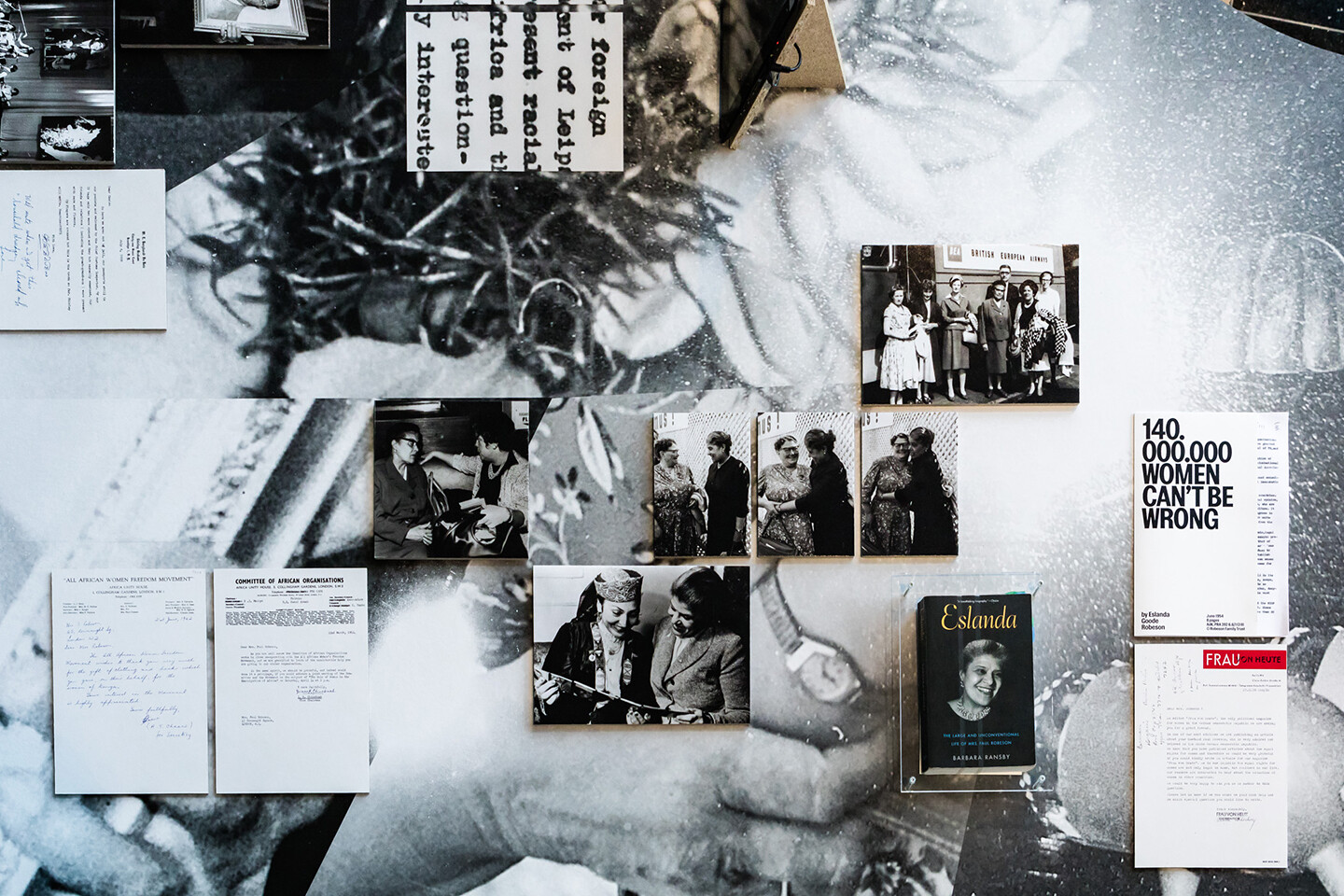

“The Missed Seminar,” Haus der Kulturen der Welt, Berlin, October 28–December 30, 2022; and Staatliche Kunstsammlungen Dresden, March 30–September 24, 2023. © Laura Fiorio, 2022.
DM: I wasn’t thinking so much of a biographical film on Paul and Eslanda, but about the fabric, the relations, the friendships, the infrastructure they were part of.
SM: Whatever you do there is an element of the biographical. You can’t escape that. It is what it is. And I didn’t want to go down that road. At the end, this is it. End Credits couldn’t have been a better demonstration of that.
DM: I wanted to mention another film reference—an unmade, unrealized film. In 1934, Paul received a letter from Sergei Eisenstein suggesting a film on the Haitian Revolution, with Paul as Toussaint Louverture. This anecdote was related by Paul Robeson Jr. in the documentary Paul Robeson: Here I Stand, directed by St. Clair Bourne, which came out in 1999. Paul Sr. also went to Moscow to speak with Eisenstein. What do you think would be needed to realize the Eisenstein film today, ninety years later?
SM: I can’t really answer that. I don’t know. I wish that it was made. That’s about all that I can say. I wish that it was made, but it wasn’t.
DM: I’m also asking because End Credits engages with the image as a tool of speaking, as politics. It goes beyond illustration. End Credits is not an illustration, yet it is an audiovisual portrait by other means, a film of extreme duration on the lives and struggles of the Robesons, as you said earlier beautifully.
SM: Yes, End Credits is not an interpretation. It’s documenting a document. It’s not a reinterpretation.
DM: The files contain an excess of documents, but through the erasures and the visibility of the infrastructure this project goes beyond the document. Am I understanding you correctly? Are we returning to the holes in the system, the redactions and erasures in the documents?
SM: It doesn’t go beyond the document. A document remains a document. These files were released in the seventies or eighties, so there is a distance. The first documents are from the mid-thirties. Now we are in 2022. They’re almost like relics now, if anything. What can we learn from these relics, from bringing them into our everyday life today? I don’t know.
DM: It makes me think of Okwui Enwezor’s exhibition “Archive Fever: Uses of the Document in Contemporary Art,” shown at the ICP in New York in 2008. The curatorial essay starts with a reflection on the archive in relation to the document and Foucault’s “law of what can be said” as evidence. End Credits exposes the whole infrastructure of surveillance. Documenting a document, as you put it, allows for honoring the practice of resistance that we witness in the documents while at the same time analyzing the violence from a distance. Documenting a document activates an estrangement effect, perhaps.
SM: There you go. An interpretation of an event in the past, which could be put into the present. What did that mean then to do a movie about Toussaint Louverture with Paul Robeson and Sergei Eisenstein? What was the intent?
See Barbara Ransby, The Large and Unconventional Life of Mrs. Paul Robeson (Yale University Press, 2013).
Eslanda Robeson, African Journey (Victor Gollancz Ltd., 1946).
Franz Loeser, Die Abenteuer eines Emigranten: Erinnerungen (Adventures of an Emigrant: Memoires) (Verlag Neues Leben, 1980).
Katharina Warda, “Ostdeutsche of Color,” Rise, 2021 → (in German).
“Pan-Africanism, Communism, Anti-Fascism: A Radical Provocation,” panel discussion with Charisse Burden-Stelly, Doreen Mende, Charlotte Misselwitz, and Zoé Samudzi, moderated by Avery F. Gordon, October 29, 2022, “The Missed Seminar,” Haus der Kulturen der Welt, Berlin.
See →.
Steve McQueen in conversation with Donna De Salvo, April 29, 2016, in the context of Steve McQueen’s exhibition “Open Plan,” Whitney Museum of American Art, 2016 →.
Eslanda Goode Robeson, “Kidnapped!” A True Story, Paul Robeson Archive, Akademie der Künste Berlin.
